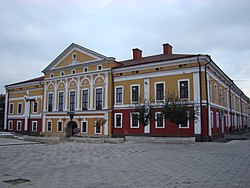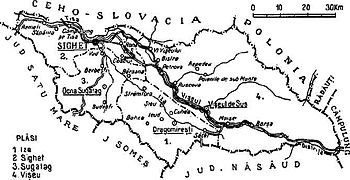This is the current revision of this page, as edited by Monkbot (talk | contribs) at 15:46, 21 October 2024 (Task 20: replace {lang-??} templates with {langx|??} ‹See Tfd› (Replaced 1);). The present address (URL) is a permanent link to this version.
Revision as of 15:46, 21 October 2024 by Monkbot (talk | contribs) (Task 20: replace {lang-??} templates with {langx|??} ‹See Tfd› (Replaced 1);)(diff) ← Previous revision | Latest revision (diff) | Newer revision → (diff) County of Romania County in Nord-Vest, Romania| Maramureș County Județul Maramureș | |
|---|---|
| County | |
         (From top to bottom and left to right) Bârsana Monastery, Merry Cemetery, Breb, Maramureș Village Museum, city centre of Sighetu Marmației, Wooden Church of Budești Josani, Wooden Church of Ieud Deal, Wooden Church of Poienile Izei, city centre of Baia Mare (From top to bottom and left to right) Bârsana Monastery, Merry Cemetery, Breb, Maramureș Village Museum, city centre of Sighetu Marmației, Wooden Church of Budești Josani, Wooden Church of Ieud Deal, Wooden Church of Poienile Izei, city centre of Baia Mare | |
 Flag Flag Coat of arms Coat of arms | |
 | |
| Country | Romania |
| Development region | Nord-Vest |
| Historical region | Maramureș |
| Capital | Baia Mare |
| Government | |
| • President of the County Board | Ionel Bogdan Ovidiu (EPP) |
| • Prefect | Rudolf Stauder |
| Area | |
| • Total | 6,304 km (2,434 sq mi) |
| • Rank | 15th |
| Population | |
| • Total | 452,475 |
| • Rank | 17th |
| • Density | 72/km (190/sq mi) |
| Telephone code | (+40) 262 or (+40) 362 |
| ISO 3166 code | RO-MM |
| GDP (nominal) | US$ 6.370 billion (2024) |
| GDP per capita | US$ 5,844 (2015) |
| Website | County Council Prefecture |
Maramureș County (Romanian pronunciation: [maraˈmureʃ] ) is a county (județ) in Romania, in the Maramureș region. The county seat is Baia Mare.


Name
In Hungarian it is known as Máramaros megye, in Ukrainian as Мараморо́щина, in German as Kreis Marmarosch, and in Yiddish as מאַרמאַראָש.
Geography
 AB
AR
AG
BC
BH
BN
BT
BV
BR
BZ
CS
CL
CJ
CT
CV
DB
DJ
GL
GR
GJ
HR
HD
IL
IS
IF
MM
MH
MS
NT
OT
PH
SM
SJ
SB
SV
TR
TM
TL
VS
VL
VN
B
AB
AR
AG
BC
BH
BN
BT
BV
BR
BZ
CS
CL
CJ
CT
CV
DB
DJ
GL
GR
GJ
HR
HD
IL
IS
IF
MM
MH
MS
NT
OT
PH
SM
SJ
SB
SV
TR
TM
TL
VS
VL
VN
B
Maramureș County is situated in the northern part of Romania, in the historical region of Transylvania, and has a border with Ukraine. This county has a total area of 6,304 square kilometres (2,434 sq mi), of which 43% is covered by the Rodna Mountains, with its tallest peak, Pietrosul [ro], at 2,303 metres (7,556 ft) altitude.
Together with the Gutâi and Țibleș mountain ranges, the Rodna mountains are part of the Eastern Carpathians. The rest of the county are hills, plateaus, and valleys. The county is crossed by Tisa River and its main tributaries: the Iza, Vișeu, and Mara rivers.
Neighbours
The neighbouring territorial units, both Romanian and foreign, to Maramureș County are listed below:
- Suceava County to the east;
- Satu Mare County to the west;
- Ukraine to the north – Ivano-Frankivsk Oblast and Zakarpattia Oblast;
- Sălaj County, Cluj County, and Bistrița-Năsăud County to the south.
Administrative divisions




Maramureș County has 2 municipalities, 11 towns and 63 communes.
- Municipalities
- Baia Mare - county seat; population: 114,925 (as of 2011)
- Sighetu Marmației
- Towns
- Communes
- Ardusat
- Ariniș
- Asuaju de Sus
- Băița de sub Codru
- Băiuț
- Bârsana
- Băsești
- Bicaz
- Bistra
- Bocicoiu Mare
- Bogdan Vodă
- Boiu Mare
- Botiza
- Breb
- Budești
- Călinești
- Câmpulung la Tisa
- Cernești
- Cicârlău
- Coaș
- Coltău
- Copalnic-Mănăștur
- Coroieni
- Cupșeni
- Desești
- Dumbrăvița
- Fărcașa
- Gârdani
- Giulești
- Groși
- Groșii Țibleșului
- Ieud
- Lăpuș
- Leordina
- Mireșu Mare
- Moisei
- Oarța de Jos
- Ocna Șugatag
- Onceşti
- Petrova
- Poienile de sub Munte
- Poienile Izei
- Recea
- Remetea Chioarului
- Remeți
- Repedea
- Rona de Jos
- Rona de Sus
- Rozavlea
- Ruscova
- Săcălășeni
- Săcel
- Sălsig
- Săpânța
- Sarasău
- Satulung
- Șieu
- Șișești
- Strâmtura
- Suciu de Sus
- Vadu Izei
- Valea Chioarului
- Vima Mică
- Vișeu de Jos
Economy
Maramureș is known for its pastoral and agricultural traditions, largely unscathed by the industrialisation campaign carried out during Romania's communist period. Ploughing, planting, harvesting, and hay making and handling are mostly done through manual labour. The county is also home to a strong mining industry of extraction of metals other than iron. The industrial plants built around Baia Mare during the communist period heavily polluted the area in the past, but recently, due to the decline of the city's industrial activity, the area has become less polluted.
Tourism

The region is known for its beautiful rural scenery, local small woodwork and craftwork industry as well as for its churches and original rural architecture. There are not many paved roads in the rural areas, but most of them are usually accessible.
The county's main tourist attractions are:
- The cities of Baia Mare and Sighetu Marmației.
- The villages on the Iza, Mara, and Vișeu Valleys.
- The Wooden churches of Maramureș
- The wooden churches of Lăpuș Country [ro]
- The wooden churches of Chioar Country [ro]
- The Merry Cemetery of Săpânța
- The Rodna Mountains, the Rodna Mountains National Park, and the Maramureș Mountains Natural Park.
- The landscape of Cavnic.
- The Memorial of the Victims of Communism and of the Resistance in Sighetu Marmației.
Demographics
Ethnic composition of Maramureș County (2021)
Romanians (84.65%) Ukrainians (including Hutsuls and other Rusyns) (6.36%) Hungarians (5.73%) Romani (2.94%) Germans (Zipser Germans and Transylvanian Saxons) (0.14%) Others (0.19%)According to the 2021 census, the county had a population of 452,475 and the population density was 71.8/km (185.9/sq mi).
| Year | County population |
|---|---|
| 1948 | 321,287 |
| 1956 | 367,114 |
| 1966 | 427,645 |
| 1977 | 492,860 |
| 1992 | 538,534 |
| 2002 | 510,110 |
| 2011 | 461,290 |
| 2021 | 452,475 |
Politics
The Maramureș County Council, elected at the 2020 local elections, consists of 34 councillors, with the following party composition:
| Party | Seats | Current County Council | |||||||||||||
|---|---|---|---|---|---|---|---|---|---|---|---|---|---|---|---|
| National Liberal Party (PNL) | 13 | ||||||||||||||
| Coalition for Maramureș (PSD) | 10 | ||||||||||||||
| People's Movement Party (PMP) | 5 | ||||||||||||||
| PRO Romania (PRO) | 3 | ||||||||||||||
| Save Romania Union (USR) | 3 | ||||||||||||||
Historical county
County in Romania| Județul Maramureș | |
|---|---|
| County (Județ) | |
 The Maramureș County Prefect's building from the interwar period. The Maramureș County Prefect's building from the interwar period. | |
 Coat of arms Coat of arms | |
 | |
| Country | |
| Historic region | Maramureș |
| Capital city (Reședință de județ) | Sighet |
| Area | |
| • Total | 3,381 km (1,305 sq mi) |
| Population | |
| • Total | 194,619 |
| • Density | 58/km (150/sq mi) |
| Time zone | UTC+2 (EET) |
| • Summer (DST) | UTC+3 (EEST) |
History
Main article: History of Maramureș- In 1199, the region is first attested.
- In 1241 the Tatar invasion decimated about half of the local population.
- In the 14th century, Duke (knyaz) Bogdan of Maramureș crossed the Carpathians and founded the Principality of Moldavia. In 1343, the Voivodeship of Maramureș, led by a Romanian nobility, is established, and it lasts until 1402.
- In the Middle Ages, the historical region of Máramaros (Maramureș) was known for its salt mines and later for its lumber.
In 1920, under the Treaty of Trianon, the northern part of the county became part of newly-formed Czechoslovakia, while the southern part (including Sighetu Marmației) became part of the Kingdom of Romania.
After the administrative unification law in 1925, the county remained as it was, with an identical name and territory.
In 1938, King Carol II promulgated a new Constitution, and subsequently he had the administrative division of the Romanian territory changed. Ten ținuturi (approximate translation: "lands") were created (by merging the counties) to be ruled by rezidenți regali (approximate translation: "Royal Residents") – appointed directly by the king – instead of the prefects. Maramureș County became part of Ținutul Crișuri.
In August 1940, under the auspices of Nazi Germany, which imposed the Second Vienna Award, the county was transferred back to Hungary with the rest of Northern Transylvania. In October 1944, Romanian forces with Soviet assistance recaptured the ceded territory and reintegrated it into Romania, re-establishing the county. Romanian jurisdiction over the county per the Treaty of Trianon was reaffirmed in the Paris Peace Treaties, 1947. The counties of Romania, including Maramureș, were disestablished by the communist government of Romania in 1950 in favour of regions, and re-established in 1968 when Romania restored the county administrative system.
Administration

In 1930, the county was originally divided into three districts (plăși):
- Plasa Iza
- Plasa Sighet (headquartered at Sighet)
- Plasa Vișeu (headquartered at Vișeu de Sus)
Subsequently, the Iza and Sighet districts were reorganized into three districts, adding one:
- Plasa Șugatag (headquartered at Ocna Șugatag)
Population
According to the 1930 census, the county's population was 194,619, 57.9% Romanian, 20.9% Jews, 11.9% Ruthenians (including Ukrainians), 6.9% Hungarians, 2.0% Germans, as well as other minorities. The following composition was recorded from the religious point of view: 64.4% Greek Catholic, 21.0% Jewish, 6.4% Roman Catholic, 5.3% Eastern Orthodox, 1.8% Reformed, as well as other minorities.
Urban population
In 1930 the county's urban population ethnically consisted of 38.6% Jews, 35.4% Romanians, 19.9% Hungarians, 4.5% Ruthenians (including Ukrainians), as well as other minorities. Yiddish was spoken by 36.6% of the urban population, followed by Romanian (33.7%), Hungarian (25.7%), Ukrainian (2.3%), as well as other minorities. From the religious point of view, the urban inhabitants were Jewish (38.9%), Greek Catholics (38.0%), Roman Catholics (12.8%), Reformed (5.7%), Eastern Orthodox (3.5%), as well as other minorities.
People
Natives of the county include:
References
- "Populaţia rezidentă după grupa de vârstă, pe județe și municipii, orașe, comune, la 1 decembrie 2021" (XLS). National Institute of Statistics.
- The number used depends on the numbering system employed by the phone companies on the market.
- "Rezultate definitive: Caracteristici etno-culturale demografice". Recensamantromania.ro. Retrieved 28 July 2023.
- National Institute of Statistics, "Populația la recensămintele din anii 1948, 1956, 1966, 1977, 1992 și 2002" Archived 2006-09-22 at the Wayback Machine
- "Rezultatele finale ale alegerilor locale din 2020" (Json) (in Romanian). Autoritatea Electorală Permanentă. Retrieved 2020-11-02.
- Portretul României Interbelice - Județul Maramureș
- ^ Recensământul general al populației României din 29 decemvrie 1930, Vol. II, pag. 276-277
External links
47°40′22″N 24°00′18″E / 47.67278°N 24.00500°E / 47.67278; 24.00500
Categories:- Maramureș County
- Counties of Romania
- Geography of Transylvania
- Rusyn communities
- 1925 establishments in Romania
- 1944 establishments in Romania
- 1968 establishments in Romania
- 1938 disestablishments in Romania
- 1950 disestablishments in Romania
- States and territories established in 1925
- States and territories established in 1944
- States and territories established in 1968
- States and territories disestablished in 1938
- States and territories disestablished in 1950
